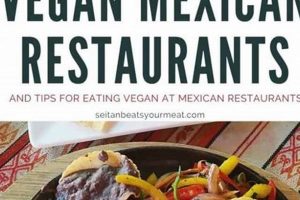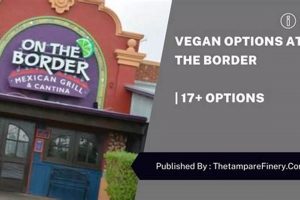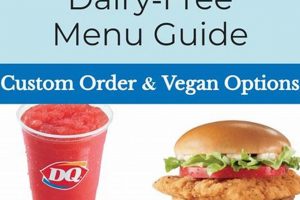Meat-free and dairy-free choices available at the Red Robin restaurant chain allow individuals adhering to a plant-based diet to dine at this establishment. Menu selections accommodating this dietary preference typically involve modifications to existing items or specific dishes prepared without animal products. For example, a burger can be ordered with a meatless patty and without cheese or mayonnaise.
The increasing demand for plant-based meals reflects a broader societal shift toward healthier eating habits and heightened awareness of environmental and ethical concerns related to animal agriculture. Providing such alternatives allows dining establishments to cater to a wider customer base and remain competitive in a market that increasingly values dietary inclusivity. Historically, the availability of these options was limited, but establishments are now recognizing and responding to this growing consumer need.
The following sections will detail specific menu items, potential modifications, and other considerations for those seeking plant-based meals at Red Robin. Furthermore, information regarding nutritional content and cross-contamination risks will be addressed.
This section offers practical advice for individuals seeking meals free from animal products at Red Robin. Careful consideration of menu items and ingredient substitutions is crucial to ensure compliance with dietary requirements.
Tip 1: Consult the Allergen Menu: Red Robin provides allergen information, which, while not specifically designed for veganism, can assist in identifying ingredients derived from animal sources, such as dairy or eggs. Reviewing this document helps confirm the absence of problematic components in prospective dishes.
Tip 2: Modify Burger Orders: Request a meatless patty, omitting cheese, mayonnaise, and any bacon or animal-derived toppings. Inquire about the ingredients in the bun to confirm it is free from milk or eggs. Substitute with lettuce wraps when available.
Tip 3: Inquire About Frying Oil: Determine if French fries and other fried items are cooked in a shared fryer with meat or seafood products. Cross-contamination is a potential concern for individuals adhering to strict dietary guidelines.
Tip 4: Scrutinize Sauces and Dressings: Many sauces and dressings contain dairy, eggs, or honey. Request oil and vinegar as a safe alternative for salads or sides. Carefully examine ingredient lists when available.
Tip 5: Explore Side Dish Options: Opt for steamed broccoli, fresh fruit, or a side salad with the appropriate modifications to dressings. Confirm that steamed vegetables are prepared without butter or animal-based seasonings.
Tip 6: Communicate Clearly with Staff: Explicitly state dietary requirements to the server. Emphasize the need for modifications and the avoidance of animal products. A clear and direct conversation minimizes potential errors.
Tip 7: Consider the Veggie Burger Patty Composition: While a “veggie” burger may seem plant-based, it might include eggs or dairy as binders. Verify the ingredients of the patty before ordering, and select a truly vegan patty, if available.
Adherence to these suggestions enhances the likelihood of a satisfactory and compliant dining experience. Diligence in verifying ingredients and communicating with restaurant personnel is essential for individuals seeking animal-product-free meals.
The subsequent sections will further investigate specific menu items and their potential for modification to align with plant-based dietary requirements.
1. Patty Composition
The composition of the patty is paramount when evaluating choices suitable for plant-based dietary preferences at Red Robin. Due to variations in ingredients across different patty types, a careful assessment is essential to ensure adherence to vegan principles.
- Binder Ingredients
Many commercially available veggie burgers utilize eggs or dairy as binding agents to maintain structural integrity during cooking. These ingredients are fundamentally incompatible with a vegan dietary standard. Determining the presence or absence of such binders is crucial when assessing patty suitability.
- Protein Source
The primary protein source within a veggie burger influences its overall acceptability. Common protein sources include soy, beans, vegetables, and grains. Ingredient listings should be reviewed to identify the specific origin of the protein, enabling individuals to make informed decisions aligned with their dietary needs and preferences. For example, some individuals may prefer a soy-free option.
- Added Flavors and Additives
Veggie burger patties frequently incorporate added flavors, spices, and artificial additives to enhance taste and texture. Certain additives may be derived from animal sources or processed using animal byproducts. Careful scrutiny of the ingredient list can reveal potentially problematic additives, aiding in the selection of truly plant-based options.
- Cross-Contamination Considerations
Even if the patty ingredients are intrinsically vegan, the preparation and cooking process might introduce contaminants. Shared cooking surfaces or utensils with meat products can pose a risk of cross-contamination, particularly for individuals with strict dietary adherence. Inquiries about cooking practices are necessary to mitigate this risk.
The meticulous evaluation of patty composition across these facets allows for informed choices regarding vegan dining selections at Red Robin. Individuals must prioritize ingredient verification and engage in direct communication with restaurant staff to ensure adherence to plant-based dietary standards.
2. Bun Ingredients
The selection of an appropriate bun is a crucial consideration when pursuing vegan options at Red Robin. While the primary focus often lies on the patty, the bun’s composition can inadvertently introduce non-vegan components, thereby compromising the integrity of an otherwise plant-based meal. The following points delineate key aspects of bun ingredients relevant to this dietary concern.
- Presence of Dairy
Many commercially produced buns incorporate milk or milk derivatives, such as whey or casein, to enhance texture or flavor. These dairy-based ingredients are unsuitable for vegan consumption and necessitate careful scrutiny of the ingredient list. Some buns may also be glazed with a milk wash prior to baking, introducing a less obvious source of dairy.
- Inclusion of Eggs
Eggs are frequently used in bun recipes as a binding agent and to contribute to a softer texture. Egg yolks can also impart a richer color to the bun. The presence of eggs, whether in whole form or as egg derivatives, disqualifies a bun from vegan consideration. Bakers often include eggs in enriched doughs.
- Use of Honey
While less common than dairy or eggs, honey may occasionally be used as a sweetener in certain bun varieties. As honey is an animal product, its inclusion renders the bun non-vegan. Awareness of this potential ingredient is crucial for strict adherence to vegan dietary principles.
- Lecithin Source
Lecithin, an emulsifier used to improve dough consistency, can be derived from soy or eggs. While soy lecithin is acceptable within a vegan framework, egg-derived lecithin is not. Identifying the source of lecithin within a bun’s ingredient list is therefore essential. However, often ingredient lists will not state the lecithin source and direct contact with the manufacturer may be required to ensure adherence.
In summary, diligent examination of bun ingredients is paramount to ensure compliance with vegan dietary requirements at Red Robin. The presence of dairy, eggs, or honey necessitates the selection of an alternative bun or the omission of the bun entirely. Direct communication with restaurant staff may be required to obtain detailed ingredient information and confirm the suitability of available bun options. Substituting for lettuce wraps or omitting the bun altogether are viable strategies to circumvent potential non-vegan elements.
3. Sauce Analysis
Thorough sauce analysis is a critical component of identifying suitable options for individuals adhering to a vegan diet at Red Robin. Many sauces, seemingly innocuous, contain hidden animal-derived ingredients that would preclude their consumption within a plant-based framework. Scrutiny of ingredients and production methods is therefore paramount.
- Dairy-Based Ingredients
Many sauces, including creamy dressings, dips, and certain condiments, frequently incorporate dairy products such as milk, cream, butter, or cheese. These ingredients are incompatible with vegan dietary standards. Examples include ranch dressing, cheese sauce, and some variations of aioli. Careful examination of ingredient lists or direct inquiry with restaurant staff is necessary to identify and avoid these dairy-containing sauces.
- Egg-Based Ingredients
Certain sauces, particularly mayonnaise and hollandaise, rely heavily on eggs for their emulsification and texture. Eggs are a non-vegan ingredient. Furthermore, some less obvious sauces may contain egg derivatives as stabilizers or thickening agents. Consequently, identifying the presence of egg-based components is essential during sauce analysis.
- Honey as a Sweetener
Honey, a product derived from bees, is sometimes utilized as a sweetener in sauces, especially in barbecue sauces or sweet chili sauces. As honey is considered an animal-derived product, it is unsuitable for vegan consumption. The inclusion of honey often requires diligent label reading, as it may not always be readily apparent.
- Fish-Based Ingredients
While less common, certain sauces, particularly in Asian-inspired cuisines, may incorporate fish sauce or other fish-based ingredients to enhance umami flavor. Fish sauce is derived from fermented fish and is unequivocally non-vegan. Consequently, individuals seeking plant-based options must carefully investigate the ingredients of such sauces.
The meticulous analysis of sauces, encompassing the detection of dairy, eggs, honey, and fish-based ingredients, is indispensable for vegan diners at Red Robin. Reliance on comprehensive ingredient information and proactive communication with restaurant personnel are crucial strategies for ensuring dietary compliance and a satisfactory dining experience. Substitution with oil and vinegar or requesting sauces on the side for individual assessment are practical approaches for mitigating potential risks.
4. Frying Methods
The selection of fried food items within a vegan dietary framework at Red Robin necessitates careful consideration of frying methods. The potential for cross-contamination and the composition of frying oils significantly impact the suitability of these items for plant-based consumption.
- Shared Fryer Contamination
A primary concern lies in the common practice of utilizing shared fryers for both plant-based and animal-derived products. French fries, onion rings, and other fried items may be cooked in the same oil as chicken, fish, or other meat products. This shared cooking environment introduces the risk of cross-contamination, rendering items otherwise composed of vegan ingredients unsuitable for strict plant-based diets. The mere contact with animal products during the frying process compromises their vegan status.
- Frying Oil Composition
The type of oil used in the frying process is another critical factor. While many establishments utilize vegetable oils, some may incorporate animal fats or tallow to enhance flavor or texture. The presence of animal fats directly contravenes vegan principles. Inquiry regarding the specific type of oil employed is therefore essential to ensure adherence to dietary requirements. Furthermore, even if vegetable oil is used, previous usage may impact current suitability if previously used to fry animal products.
- Batter Ingredients
For items such as onion rings or fried pickles, the batter itself may contain non-vegan ingredients, such as milk or eggs. A careful examination of the batter composition is necessary to identify and avoid such components. Even if the item is fried in acceptable oil, a non-vegan batter will render it unsuitable. Therefore, requesting items without batter or inquiring about its ingredients is advisable.
- Filtration Practices
The process of filtering frying oil to remove food particles can inadvertently contribute to cross-contamination. If the filtration system is not thoroughly cleaned between uses, residues of animal products may persist and transfer to subsequent batches of fried food. Understanding the restaurant’s filtration practices can further inform decisions regarding the acceptability of fried items.
In summation, evaluating frying methods represents a crucial step in navigating plant-based choices at Red Robin. The potential for cross-contamination via shared fryers, the composition of frying oils, the ingredients within batters, and the nuances of filtration practices all contribute to the overall suitability of fried food items for individuals adhering to vegan dietary principles. Thorough inquiry and diligent assessment are essential to ensure compliance with these standards.
5. Dairy Omission
Dairy omission is a foundational element in the selection of vegan options at Red Robin. The elimination of all dairy-derived ingredients is a prerequisite for any menu item to be considered suitable for individuals adhering to a plant-based diet. The following facets detail the complexities associated with ensuring complete dairy absence within the Red Robin dining context.
- Hidden Dairy Derivatives
Dairy products may appear in less obvious forms within menu items. Whey, casein, and lactose are common dairy derivatives used as additives or stabilizers in sauces, dressings, and even seemingly non-dairy products. These hidden sources necessitate diligent ingredient scrutiny beyond the obvious presence of milk, cheese, or butter. The allergen menu, while not specifically designed for vegan diets, can assist in identifying these less apparent sources.
- Cross-Contamination Risks
Even if an item is formulated without dairy ingredients, the potential for cross-contamination during preparation poses a significant concern. Shared cooking surfaces, utensils, and fryers can transfer dairy residues to otherwise vegan-compliant items. Restaurants must implement strict protocols to prevent cross-contamination. Direct inquiry with staff about preparation procedures is essential for those with strict dietary requirements.
- Sauce and Dressing Scrutiny
Sauces and dressings are frequent sources of hidden dairy ingredients. Cream-based sauces, cheese sauces, and even some vinaigrettes may contain dairy. Mayonnaise typically contains eggs but can also include dairy derivatives. Careful review of ingredient lists or direct communication with restaurant personnel is necessary to ascertain the dairy-free status of these accompaniments. Opting for oil and vinegar as a dressing alternative is a prudent strategy.
- Bun and Bread Considerations
Many commercially produced buns and bread items incorporate dairy ingredients for enhanced texture and flavor. Milk, butter, or whey may be added to the dough. Careful examination of ingredient information is crucial to ensure that the chosen bun or bread is dairy-free. Substituting for lettuce wraps is a potential workaround.
The successful navigation of vegan options at Red Robin hinges on a comprehensive understanding and meticulous application of dairy omission principles. Vigilance in identifying hidden dairy derivatives, mitigating cross-contamination risks, scrutinizing sauces and dressings, and carefully selecting buns and breads are all essential components of this process. A proactive approach, involving detailed ingredient verification and clear communication with restaurant staff, is paramount for ensuring a truly dairy-free dining experience.
6. Cross-Contamination
Cross-contamination represents a significant challenge in the provision of verifiable vegan options at Red Robin. The potential transfer of animal-derived substances to otherwise plant-based ingredients compromises the suitability of menu items for individuals adhering to strict vegan dietary principles. This occurs primarily through shared equipment and inadequate segregation during food preparation processes. For example, French fries, composed entirely of plant-based ingredients, may be rendered non-vegan if fried in the same oil used to cook chicken or fish. Similarly, a vegetable burger prepared on a grill previously used for meat products exposes the burger to animal fats and proteins. This compromises its status. This issue is not limited to cooking surfaces. Utensils, cutting boards, and even the hands of food preparation staff can serve as vectors for cross-contamination, introducing minute but consequential amounts of animal products into ostensibly vegan dishes.
The importance of understanding and mitigating cross-contamination risks extends beyond simple adherence to dietary preferences. For individuals with severe allergies to animal products, even trace amounts resulting from cross-contamination can trigger adverse reactions. Consequently, clear communication between restaurant staff and patrons regarding preparation methods becomes crucial. Red Robin, like many establishments, faces the ongoing challenge of implementing and enforcing robust protocols to minimize these risks. This requires not only the provision of vegan-friendly ingredients but also a commitment to staff training, dedicated equipment, and rigorous cleaning procedures. Failure to address cross-contamination adequately undermines the integrity of any purported plant-based offerings, potentially leading to both ethical and health-related consequences for consumers.
The practical significance of acknowledging cross-contamination lies in empowering informed consumer choices. By understanding the inherent risks and asking pertinent questions about preparation methods, individuals can make informed decisions about their meals. While Red Robin may offer menu items containing exclusively plant-based ingredients, the ultimate suitability of those items hinges on the restaurant’s demonstrated commitment to preventing cross-contamination. The establishment of transparent and verifiable procedures, coupled with ongoing staff training, represents the most effective means of ensuring genuine vegan options are available, thereby addressing the challenges and ensuring the integrity of the restaurant’s plant-based menu offerings.
7. Vegetable Preparation
The preparation of vegetables represents a critical, often overlooked, aspect of providing verifiable vegan options at Red Robin. While a menu item may feature vegetables, the methods employed in their preparation can render them unsuitable for strict plant-based diets. Careful consideration of seasoning, cooking mediums, and potential cross-contamination is essential.
- Butter and Dairy-Based Glazes
Steamed or sauted vegetables frequently incorporate butter or dairy-based glazes to enhance flavor and visual appeal. These additions, while seemingly minor, directly contravene vegan principles, rendering the vegetables non-compliant. The routine use of butter as a default seasoning necessitates specific requests for preparation without dairy products.
- Animal-Based Broths and Stocks
Certain vegetable dishes, particularly soups or side dishes, may be prepared using animal-based broths or stocks as a flavoring agent. These broths, derived from meat or bones, impart a non-vegan element to the vegetables, regardless of their intrinsic plant-based nature. Inquiring about the broth’s origin is crucial for ensuring dietary suitability.
- Cross-Contamination during Preparation
Vegetables prepared on surfaces or with utensils previously used for animal products face the risk of cross-contamination. Shared cutting boards, grills, or cooking pans can transfer minute amounts of animal fats or proteins to the vegetables, compromising their vegan status. Dedicated preparation areas and equipment are necessary to mitigate this risk effectively.
- Honey and Non-Vegan Sweeteners
Glazed carrots or other sweetened vegetable preparations may utilize honey as a sweetener. As honey is an animal-derived product, its inclusion renders the vegetables unsuitable for vegan consumption. Careful scrutiny of ingredient lists and proactive communication with restaurant staff are required to identify and avoid this potential pitfall.
These considerations underscore the complexity of ensuring truly vegan vegetable preparations at Red Robin. Beyond the inherent plant-based nature of the vegetables themselves, the employed seasonings, cooking mediums, and potential for cross-contamination all contribute to their ultimate suitability for strict plant-based dietary standards. Proactive engagement with restaurant staff and a meticulous review of ingredient information are essential strategies for navigating these challenges effectively.
Frequently Asked Questions
This section addresses common inquiries regarding the availability and suitability of plant-based meals at Red Robin, providing clear and concise answers to frequently encountered concerns.
Question 1: Are there truly vegan-certified menu items available at Red Robin?
Red Robin does not possess official vegan certification from third-party organizations for its menu items. The availability of suitable plant-based options relies on careful selection and modification of existing menu items.
Question 2: How can cross-contamination be avoided when ordering vegan meals?
Cross-contamination poses a risk due to shared cooking surfaces and equipment. Explicitly requesting dedicated preparation and cooking procedures from restaurant staff is recommended to minimize this risk.
Question 3: What are the most reliable vegan modifications to existing Red Robin menu items?
Modifying burgers by substituting a suitable plant-based patty, omitting cheese and mayonnaise, and carefully scrutinizing the bun ingredients represents a common adaptation. Additionally, selecting side dishes such as steamed broccoli or fresh fruit offers reliable plant-based choices.
Question 4: How can the ingredients of sauces and dressings be verified for vegan compliance?
Ingredient lists, when available, should be meticulously examined. Direct inquiry with restaurant staff regarding specific ingredients is essential. Opting for simple dressings like oil and vinegar minimizes potential risks.
Question 5: Are the French fries at Red Robin suitable for vegans?
The suitability of French fries depends on the frying oil used and the potential for cross-contamination. Determining whether the fries are cooked in a shared fryer with animal products is crucial. The type of oil utilized must also be verified.
Question 6: What steps should be taken when uncertainty exists regarding an ingredient’s vegan status?
When uncertainty persists, avoiding the item altogether is the most prudent course of action. Prioritizing transparency and proactive communication with restaurant staff is vital for making informed decisions.
Key takeaways include the importance of proactive communication, ingredient verification, and the acknowledgment of potential cross-contamination risks when seeking plant-based meals at Red Robin.
The subsequent section will provide a summary of strategies for navigating the Red Robin menu and ensuring a satisfactory vegan dining experience.
The preceding analysis demonstrates the complexities inherent in identifying viable “vegan options at Red Robin.” Reliance on inherent assumptions regarding ingredient composition proves insufficient. Proactive engagement, characterized by detailed inquiry concerning ingredients, preparation methods, and potential cross-contamination, is essential for individuals adhering to strict plant-based dietary principles. Furthermore, menu modifications, such as omitting dairy-based toppings and scrutinizing bun ingredients, represent a crucial strategy for adapting existing items to align with vegan standards.
The provision of transparent and readily accessible ingredient information remains paramount for fostering dietary inclusivity within the restaurant industry. While the onus rests on the consumer to exercise diligence in dietary selection, establishments bear a responsibility to facilitate informed choices. Ultimately, the availability of genuine “vegan options at Red Robin” hinges on a collaborative effort, driven by both consumer awareness and institutional accountability.







